The Samsung Galaxy S6 and S6 edge Review
by Joshua Ho on April 17, 2015 9:00 AM EST- Posted in
- Smartphones
- Samsung
- Mobile
- Galaxy S6
- Galaxy S6 Edge
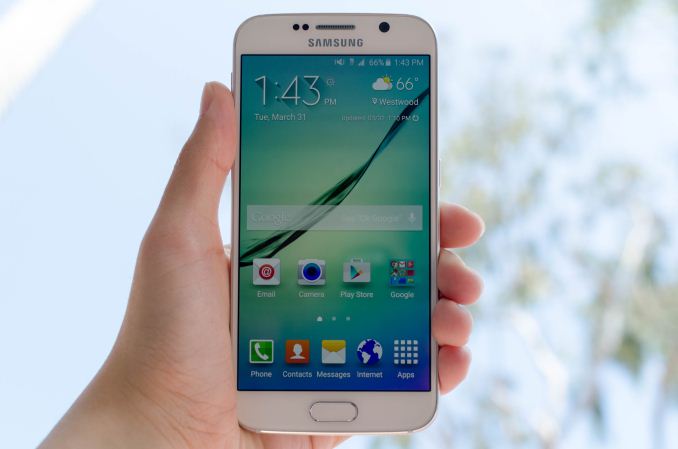
As recently as the Galaxy S5, Samsung had a fundamentally different strategy from companies like HTC and Apple. While design wasn’t ignored completely, Samsung Mobile had a different set of priorities. In general, it felt like Samsung wanted the phone to have every feature possible to please every possible potential customer. Features like a removable battery and microSD card slot seemed to be a crucial point of differentiation. TouchWiz focused on delivering a full suite of applications even if they were pretty much redundant when compared to Google’s applications. Samsung also seemed to cost-optimize their external shells, favoring polymer builds over glass or aluminum. Since the Galaxy S, this strategy paid off handsomely. With the help of strong marketing, Samsung proceeded to dominate the Android market from the days of the Galaxy S2, to the point that almost no other Android OEM was relevant in terms of market share.
However, Samsung’s tried and true strategy failed with the Galaxy S5. Fundamentally, Samsung had always been competing with Apple and their iPhone line-up at the high end, but Samsung consistently held a price advantage. The real problem was the rise of low-cost flagship phones, which squeezed Samsung significantly. Other OEMs were able to justify their high-end pricing by delivering a polished software experience and premium hardware design. In comparison to these relatively cheap phones which delivered largely the same experience and hardware, Samsung’s sales crumbled and the Galaxy S5 didn’t meet sales expectations.
This brings us to the Galaxy S6, which is supposed to be Samsung’s attempt at refocusing their product design and lineup. Design has become a major priority, and the Galaxy S6 is a radical departure from previous design in terms of almost every design choice. The Galaxy S6 represents the best that Samsung can make to some extent, as a great deal of the phone is composed of Samsung-made parts to achieve maximum vertical integration as seen in the specs below.
| Samsung Galaxy S5 | Samsung Galaxy S6 | Samsung Galaxy S6 Edge | |
| SoC | MSM8974ACv3 2.45 GHz Snapdragon 801 | Exynos 7420 2.1/1.5GHz A57/A53 | Exynos 7420 2.1/1.5GHz A57/A53 |
| RAM | 2GB LPDDR3 | 3GB LPDDR4-1552 | 3GB LPDDR4-1552 |
| NAND | 16/32GB NAND + microSD | 32/64/128GB NAND | 32/64/128GB NAND |
| Display | 5.1” 1080p SAMOLED HD |
5.1” 1440p SAMOLED |
5.1” 1440p SAMOLED, Dual Edge |
| Network | 2G / 3G / 4G LTE (Qualcomm MDM9x25 UE Category 4 LTE) | 2G / 3G / 4G LTE (Category 6 LTE) | 2G / 3G / 4G LTE (Category 6 LTE) |
| Dimensions | 142 x 72.5 x 8.1 mm, 145 grams | 143.4 x 70.5 x 6.8mm max, 138 grams | 142.1 x 70.1 x 7.0mm max, 132 grams |
| Camera | 16MP (5132 x 2988) Rear Facing with 1.12 µm pixels, 1/2.6" CMOS size, 31 mm (35mm effective), f/2.2 | 16MP (5132 x 2988) Rear Facing w/ OIS, f/1.9, object tracking AF | 16MP (5132 x 2988) Rear Facing w/ OIS, f/1.9, object tracking AF |
| 2MP Front Facing | 5MP Front Facing, f/1.9 | 5MP Front Facing, f/1.9 | |
| Battery | 2800 mAh (10.78 Whr) | 2550 mAh (9.81 Whr) | 2600 mAh (10.01 Whr) |
| OS | Android 4.4 w/TouchWiz |
Android 5 (64-bit) w/TouchWiz | Android 5 (64-bit) w/TouchWiz |
| Connectivity | 802.11a/b/g/n/ac 2x2 + BT 4.0 (BCM4354), USB3.0, GPS/GNSS, MHL, DLNA, NFC |
2x2 802.11a/b/g/n/ac + BT 4.1 (BCM4358), USB2.0, GPS/GNSS, NFC |
2x2 802.11a/b/g/n/ac + BT 4.1 (BCM4358), USB2.0, GPS/GNSS, NFC |
| Wireless Charging | N/A | WPC 1.1 (4.6W) & PMA 1.0 (4.2W) |
WPC 1.1 (4.6W) & PMA 1.0 (4.2W) |
| Fingerprint Sensor | Swipe | Touch | Touch |
| SIM Size | MicroSIM | NanoSIM |
NanoSIM |
Design
There’s a lot of ground to cover in the Galaxy S6 and S6 edge, but probably the most immediate change is to the design. The Galaxy S6 is a unibody design, with no apparent screws. This does mean that there’s no removable battery or microSD slot, which shouldn’t be a problem for most people although this may be enough for some to write off this phone completely.
The back cover is now glass instead of plastic, and is attached to the phone with glue instead of plastic latches. Regardless of color or model, Samsung has placed an extremely fine pattern beneath the glass that manages to be subtle but also surprisingly brilliant under direct light. It’s tasteful in a way that the Galaxy S5 and Note 4 weren’t. The back of the phone also has a single LED flash, a heart rate monitor, and the camera which bulges out significantly. I personally don’t have a problem with camera humps, but the Galaxy S6’s camera hump is probably the biggest I’ve seen in recent memory.
The glass back cover meets the metal frame of the phone, which provides most of the structural rigidity and strength. On the normal Galaxy S6, this frame has a very slight curve and is almost cylindrical along the top and bottom of the phone, but flattens out along the sides for better grip. The bottom of this frame has the speaker, microUSB port, and 3.5mm headphone jack, which does make for some resemblance with Apple products launched within the last year. At any rate, the placement of the speaker, USB port, and 3.5mm jack are all appropriate for a phone.
The left side of the frame contains the volume buttons, which are clicky and solid, although pressing the buttons off-center does produce a noticeable flex. The right side of the frame has the power button and the nanoSIM slot on the normal version.
On the edge variant, the sides of the frame are dramatically thinner and appear to be angled out when compared to the Galaxy S6. In the hand, this makes it feel much thinner than the S6, but it really feels almost too thin to hold comfortably. Combined with the flat back, it’s really a bit of a struggle to pick up the edge off of a table, which compromises usability when compared to the normal S6.
The top of the frame contains the IR LED for TV capabilities and a hole for a microphone. On the edge variant, the nanoSIM slot is relocated to the top of the phone.
The front of the phone is probably the only aspect of the design that feels relatively similar to the Galaxy S5. However, the texture of the bezel beneath the glass is similar to the subtle finish of the back cover, which makes for a unique visual effect that manages to be tasteful and quite unique. Other than this, we see the same layout as most Galaxy phones, with two capacitive buttons (multitasking on the left, back button on the right) and a physical home button. In the case of the Galaxy S6, this home button has been turned into a fingerprint scanner that is touch-based rather than a swipe sensor. Along the top of the front face, we also see the ambient light sensor, a proximity sensor, the earpiece, and the 5MP front-facing camera. Directly below these items is the display driver beneath the bezel, which is similar to the “logo bar” of the One M7, M8, and every other phone on the market today. On the S6 edge, the sides of the display are curved to reduce the width of the phone, which does make it easier to hold in the hand, but there’s really no bezel reduction here as the side bezels seem to be larger than what we see on the S6.
Overall, the design of the Galaxy S6 and S6 edge is really unlike anything else they’ve produced in recent memory. The phone itself is well-sized and feels much more ergonomic than the Galaxy S5 due to the thinner build and mildly reduced bezel size. It really feels like Samsung cared about the design of the phone this generation, and the attention to detail here immediately puts Samsung near the top in this area. The front of the phone still feels a bit derivative, but I suspect that there isn’t much Samsung can do to change this when faced with design constraints like a physical home button. The S6 edge does look better in some ways, but ergonomically the sharper and thinner edge is a compromise compared to the normal S6. Either phone is still easily one of the best-designed phones I’ve seen this year.


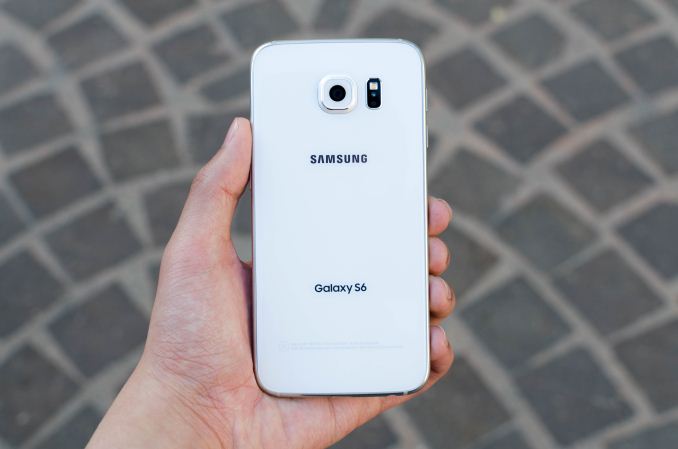
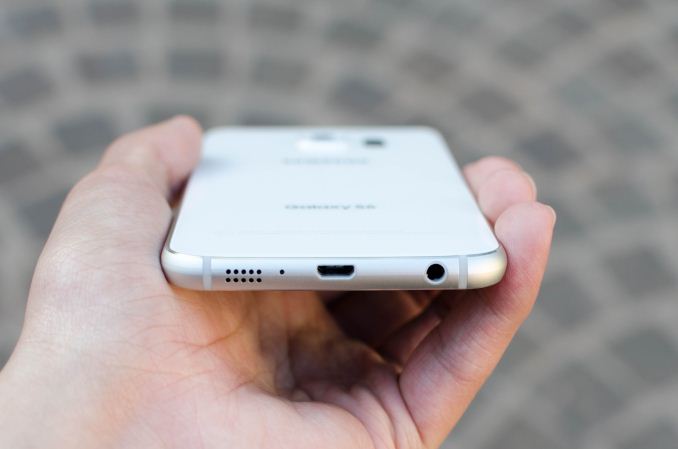
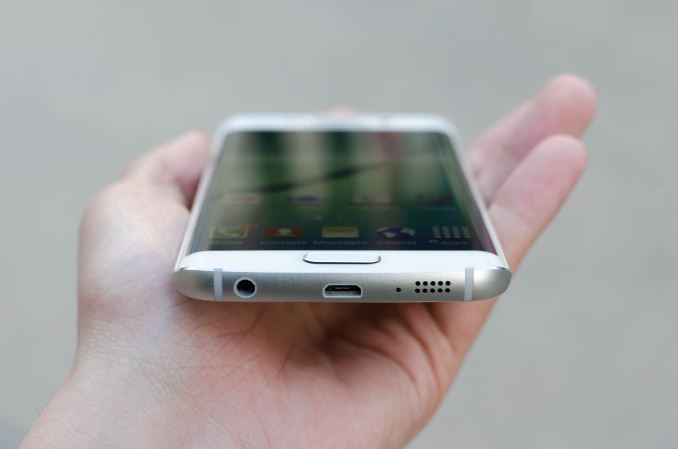



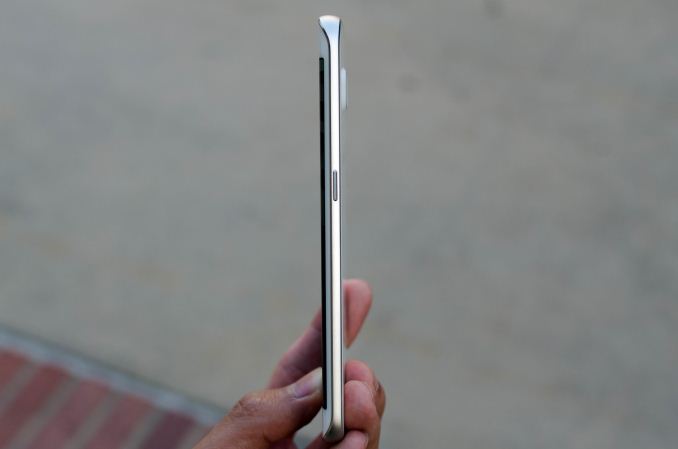

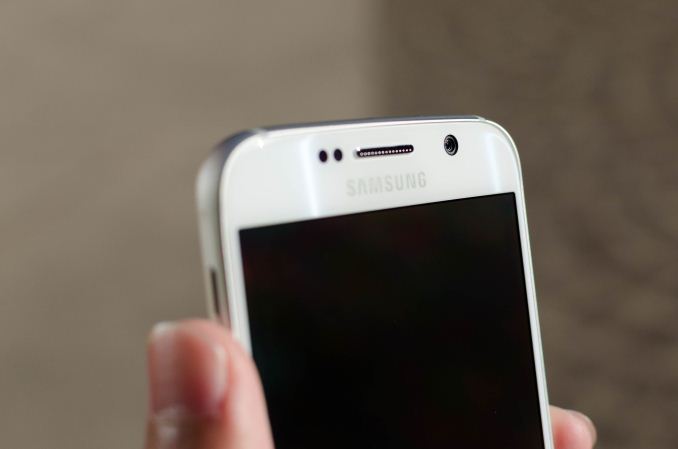
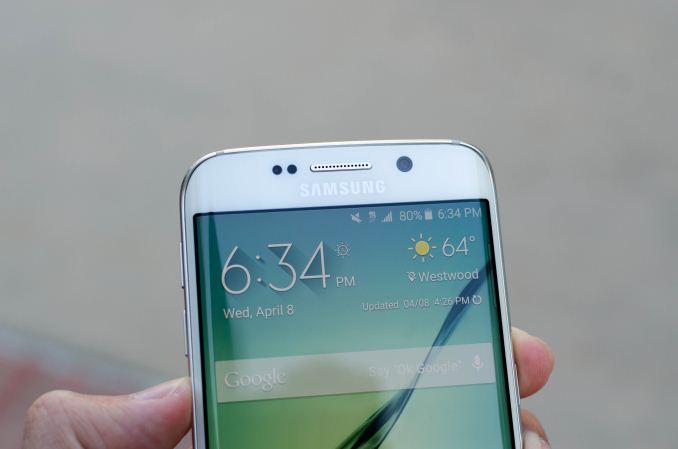








306 Comments
View All Comments
CrazyElf - Friday, April 17, 2015 - link
I just hope the Note 5 comes with expandable storage and a removable battery.Equally annoying is that it as lost waterproofing. On paper at least, it should be easier to waterproof a phone with no removable battery. That and accidents happen. The glass back too is form over function. Give us a metal back or something like carbon fibre.
whiteiphoneproblems - Friday, April 17, 2015 - link
Playing with the Edge, I noticed that the curves of its screen create undesirable light reflections. Any comments on this?JoshHo - Friday, April 17, 2015 - link
I noticed interference effects as well, which is discussed in the display section. Overall there are some notable compromises with the edge with relatively little benefit. Combined with the steep price increase and I find it hard to justify buying one over a 64 GB GS6.whiteiphoneproblems - Saturday, April 18, 2015 - link
Thanks - sorry to make you repeat yourself.nyonya - Friday, April 17, 2015 - link
Great review! Any chance you guys will get a Verizon or Sprint variant? Would love to see the battery life tests with the Qualcomm modem in those.victorson - Friday, April 17, 2015 - link
Nothing about the front facing camera?Ammaross - Friday, April 17, 2015 - link
It's a selfy-cam. Don't like it? Take pictures in the bathroom mirror like the rest of them. I doubt Skype et al pixelated video chat will care about slight distortions at the edge of the FoV or slight aliasing for striped objects, etc. :Pjohnnohj - Friday, April 17, 2015 - link
The S5 (and Note 4?) used to have a serious problem with edge distortion on the front-cam. I wonder if it's present on the S6.See this thread for examples http://forums.androidcentral.com/samsung-galaxy-s5...
akdj - Sunday, April 26, 2015 - link
I've got the Note 4, can't comment on the S5. I've never used one. But the Note 4, if so inclined allows you to take 'selfies' with the front (main) camera. You set your phone where you want it (actually according to where you want you;)) -- it looks slick. I've never used it. You frame/focus/lock exposure where you'll be 'posing' yourself or with a group. Take position. It recognizes a face. Flashes a light, counts down a couple seconds and snaps.Regardless, they're using a nice wide aperture and high megapixel selfie cam (that also shoots decent 1080p video for conferencing). It's definitely a step 'up' from most of the competition including the iPhone (I'm ambidextrous, the 6+ is my personal phone. I run our business with the Note4). Note 4's 'selfie' cam definitely beats up on my iPhone's. But then again, FaceTime is extremely cool, more reliable than Skype and convenient that Voice. Be cool if one of the three would open their face 'facing' software as open source/X-Platform, secure and not subsidized by data mining/search dollars or near trillion dollar company servers like Apple's.
More n more fills are using this camera, not necessarily for selfies but conferencing and team meetings. Between the two I've got, while the Note's is a better face cam IMHO, it's slight. And that's for both front and rear. They're both phenomenal in comparison to the 2007 iPhone I owned, the '08 Android, and any iPad or Xoom/Nexus I've owned --- and with a ten year old son, going through Google's Drive photos/Picassa and iCloud, both of which I was using pre 2007 for email and DSLR & visual storage or transfer, I'm now able to watch my son grow up in front of the computer.
So much different than my mom's photo albums of my three younger brothers ( all of us married, with kids now) & I.
These cameras and their storage software/data management subsystems have grown in leaps and bounds in the past couple years ...ita going to be interesting in thirty years to see what my son's 'photo albums' look like. If you were born in the last decade, your entire LIFE will be online and documented photographically
Practice Safe Selfies! I've got stories from friends about watching 'slide shows' with their teenagers or college kids that are hilarious! I'm not so sure they need to improve selfies significantly -- beyond today's capabilities. There's a fine line between too much detail and improved clarity on a wide angle closely focused, and hence distorted facial or grainy 'length' shots. I think nearly all selfie cams suffer not only edge distortion but soft corners/vignette, low resolution, tiny sensors and bad skin tones. They're more than fine for casual web shots but I don't want to see the pores of the race of the person I'm chatting with. Too distracting!
akdj - Sunday, April 26, 2015 - link
Ugh!*Edit* paragraph two is supposed to say 'More folks' not fills.
**Edit 2** last, main sentence '..the (f)ace of the person I'm chatting with!'
J